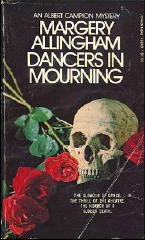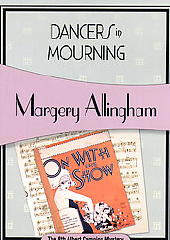Sat 27 Dec 2008
MARGERY ALLINGHAM – Dancers in Mourning.

Manor, paperback reprint, 1976. First edition: William Heinemann, UK, 1937. US first: Doubleday Crime Club, 1937. Also published as: Who Killed Chloe? Avon Murder Mystery Monthly #17, 1943. Many other paperback reprints including: Jonathan Press Mystery J32; Macfadden, 1967; Bantam, 1990; Carroll & Graf, 1996; Felony & Mayhem, trade ppbk, 2008.
One wonders how many other novels first published in 1937 are still in print. I’m not wondering hard enough to actually sit down at the computer and do some investigating, mind you, but in any case, and this is the point, Dancers in Mourning is one of them. (I also have a feeling that of the set of novels first published in 1937 but still in print, a sizable percentage of them would be mysteries.)
I’ve read two of Allingham’s mysteries that I remember: one with Mr. Albert Campion and one without, and the one with Mr. Campion I remember more than the other. But I don’t remember Mr. Campion himself very well, and I think that Allingham rather wanted it that way.

I remember large spectacles and a sometimes vacuous look on his face from that book (title not remembered off-hand) and now this one. Other than that many of the other characters in this book consider him “young,” I’d be hard-pressed to describe him further.
There is a convergence of two worlds in Dancers in Mourning. First, the world of the theatre, or musical comedy, to be specific, the world of superstar dancer Jimmy Sutane and his sell-out production of The Buffer, based on the fictional memoirs of Campion’s friend, Mr. William Faraday (who also appeared in Police at the Funeral).
And secondly, and more importantly, the setting changes to that of Sutane’s country home, where people in show business and with show business connections drop in and out, but the core of people around Sutane are all either good friends or family.
But, and here is where Campion is drawn in, who is playing all of the small but nasty practical jokes on Sutane? And, as it happens, who killed Chloe, the aging songstress who invited her way down for the weekend? Or was it suicide, or a natural death before falling from a small bridge in front of Sutane’s automobile?
Campion’s progress on the case is hampered by the discovery that is falling in love with Sutane’s wife, or that he could very easily, given any sign of reciprocation, even to extent of making several serious mistakes along the way.
Some of the characters flit and out without being recognized as more than shadows of people, others I suspect I will remember for a long time. In terms of general atmosphere, I was reminded of John Dickson Carr more often than not, although the romance elements in Carr’s work were never as crucial (or real) as they are in this one.
On the other hand, there is no locked room mystery involved in Dancers in Mourning. Only a murderer with no compunction about killing, including a home-made bomb at a railway station. Once again it is Campion’s preoccupation with other matters that make the ending work as well as it does.
Of course the solution is obvious, and it should have been all along. And so help me, it wasn’t – all the way up the final two or three pages
December 28th, 2008 at 2:52 pm
One of the books I re-read this year was John Dickson Carr’s She Died a Lady. A very enjoyable change of pace for me these days — and the romance elements were crucial!
Keith
December 28th, 2008 at 5:15 pm
Chap
Note to myself. Never make statements you can’t back up!
On the other hand, I don’t think the romance in the Carr book, which I don’t remember reading right now, is crucial in the same way as it is in the Allingham book. I’d rather not say more, as it’s so important to the ending, but my impression of the romances in the Carr books is that they were roughly drawn with bold strokes, whereas in Dancers, the romance is melancholy and as sheer as a wisp of fog in the moonlight.
Best
— Steve
December 30th, 2008 at 7:06 pm
Steve
Maybe you should read She Died a Lady, one of the “Carter Dickson” books with Sir Henry Merrivale as the detective, then will be able to rely on your own judgment. The plot hinges on “grand passion”, “infatuation” and “martyrdom” — all words freely used by H.M. in the customary, last-chapter explanations of what really happened. “It was canoodlin’ that got that poor devil into all his trouble,” says the irascible H.M.
Like you, I can say no more without going into spoiler territory!
Keith
December 31st, 2008 at 12:01 am
Keith
Doing my best to not say more than I should, I see that I’ve already indicated that it was Mr Campion who found himself falling in love.
Is H.M. already married? I fear I do not remember. Fat chance otherwise, though, he falling in love in one of Carr’s detective stories!
— Steve
PS. I did say Carr used broad strokes. “Grand passion” and “canoodlin'” indeed.
January 1st, 2009 at 2:30 pm
No, Steve, H.M. is not married. And he is a great deal more fun than Dr Gideon Fell!
K.
December 13th, 2018 at 6:43 pm
[…] with that married woman casts a disabling pall over his crime-solving work. This aspect of the narrative doesn’t always work, and it weakens the quality of detection that Campion undertakes. Yet […]